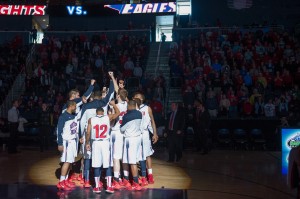
The Northwestern football team shook the foundation of college athletics last on March 26 when Peter Ohr, regional director of the National Labor Relations Board, ruled that scholarship players have the right to unionize.
The impact of the decision is going to change the structure of major college sports and force reevaluation of the term “student athlete.” Ruling the players are employees of the university gives way for many different scenarios.
“I think greed has finally met its match. The initial response to this is, ‘Oh, this just can’t work,’ and under the current structure, that may be true,” said USI head basketball coach Rodney Watson. “Of course it’s going to go to the Supreme Court. If they rule that it is constitutional, it’s going to change the structure of college athletics, and that may not be bad.”
However, Watson believes that teams at the Division II level and lower, such as USI, will not be affected by the decision. Revenue generated at larger universities helps make the distinction between the amateur and professional status issued to teams.
“Our guys don’t want to unionize because if it comes to profit sharing, they might be paying their own way,” Watson said.
The Northwestern team claims compensation comes in the form of scholarships and the safety of the players is what truly concerns them.
Former Wabash College football player Charles Kolisek suffered from a blown out knee and missed most of his junior season. He said player safety is the ultimate goal.
“Several instances in which a student athlete experiences a career ending injury and, as a result, lose their scholarship and can no longer afford to go to college exist. Unionizing for some type of ‘workers compensation’ can help combat this issue. Despite these motives, there will be several players that join out of greed in order to get paid to play college athletics,” Kolisek said. “I have blown out my knee in college, which is a pretty devastating injury, but my insurance, coupled with the NCAA’s insurance policies, took care of practically all costs that my injury incurred.”
The status of Wabash as a DIII college means athletic scholarships are not issued to its players. Kolisek admits this keeps away the pressure faced by many DI athletes to maintain their scholarship.
Coach Watson feels the two forms of insurance that helped Kolisek, coupled with state of the art equipment and elite training staffs, can treat and prevent most injuries. He noted the quick recovery of center Aaron Nelson’s ACL tear last year. Still, money remains the driving force in his opinion.
“Bottom line of unionization is they want part of that profit. They can say (injuries) are the real reasons. The real reason is they are seeing those millions (of) dollars generated on Saturdays,” Watson said of players citing medical issues as the primary cause of unionization.
Northwestern University has appealed the decision won by its athletes. The legal process will carry on as the NCAA, who has already issued a statement of their disagreement with the decision, fights to preserve the current structure of college sports.
The reasons behind unionization make little difference. College athletics is going to endure change. Whether this change comes in the form of structure, policy or how society perceives the role of the athlete has yet to be determined.


